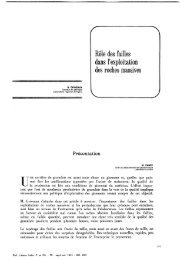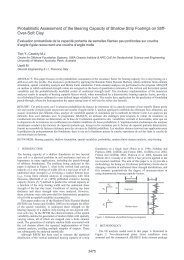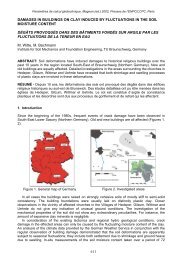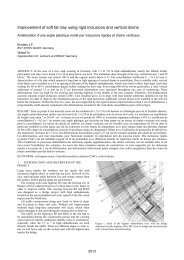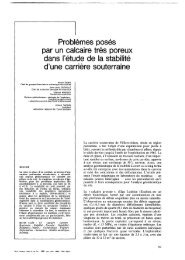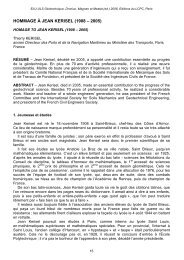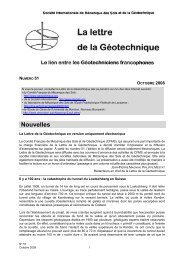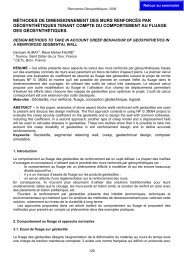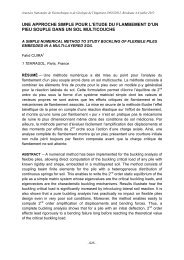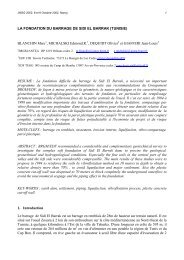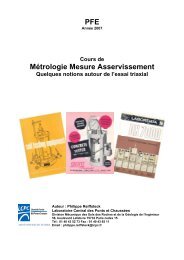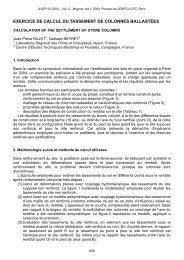THE VIBRATORY PILE INSTALLATION TECHNIQUE - Viking
THE VIBRATORY PILE INSTALLATION TECHNIQUE - Viking
THE VIBRATORY PILE INSTALLATION TECHNIQUE - Viking
You also want an ePaper? Increase the reach of your titles
YUMPU automatically turns print PDFs into web optimized ePapers that Google loves.
2.6. Accessories and Driving AidesBecause of the diverse conditions under which different pile-geometries are driven, it might benecessary to supplement the regular equipment by various pieces of additional equipment suchas; i.) air- and/or water jetting aggregates in order to displace a proper soil volume by means ofa jet with the right pressure and volume of either water or air to allow the discharged soilvolume to come up around the pile to the surface, ii.) appropriate clamping device in correlationto both sizes of vibro-unit, as well as shape and type of pile, iii.) the use of biodegradable oils ifenvironmental concerns are of important issue due to possible oil spill and iv.) silencingaccessories for noisy power units when nuisance are of importance.3. <strong>VIBRATORY</strong> DRIVEN <strong>PILE</strong>SVibratory drivers/extractors can be used to drive a large variety of piles. However the techniqueperforms best with non- or low displacement piles such as; sheet piles, H- and I-beams, openendpipe piles such as caissons and anchor piles. However this will most likely come to changewhen the mentioned new ‘directional force’ vibrator comes into full production, see Tab. 1.Furthermore, some pile-related engineering issues are also mentioned in the following sections,which contractors frequently neglects and sometime times becomes a concern.3.1. Type of piles installed with vibratory driversThe vast majority of pile-types installed by vibratory drivers/extractors are low-displacementpiles, such as sheet piles and H- and I-beams. The use of vibro-technique to install bearingpiles, (normally equivalent to displacement piles), is very rare in the Untied States, mostly froman historical point of view, but more common in other parts of the world, main reasons being thelack of methods to determine ultimate capacity from vibratory driving records. The lack of bothfield observational methods, as well as instrumentation methods to assess obtained bearingcapacity, (like blow counts and PDA-monitoring). The process today of getting the engineeringacceptance of using a vibro-unit to drive piles, consists of bringing in an impact hammer, to redrivethe vibro-installed piles, using a PDA to assess obtained capacity.Close-ended pipe piles and concrete piles, categorized as displacement piles, is normally notas easy to vibrate in comparison to low displacement piles, main reason being the difficulty topick a vibro-unit that has the capacity to overcome the dynamic toe resistance R t . The vibratoryequipmentneeds to be able to generate both enough F d as well as S p to overcomecorresponding R t , (thus allowing the pile to penetrate), representing the soil volume needed tobe displaced during each loading cycle. The initial stress states of either dense or mediumdense sand, appears to give rise to either the fast or the slow vibratory penetrative modes. Thistopic is at present poorly understood, however have been extensively studied (Dierssens 1994;Cudmani 2001).Precast prestressed (PCPS) concrete piles do not always need to be driven with conventionalimpact hammers. It’s actually feasible to drive PCPS concrete piles successfully using thevibratory technique. Previous successful experiences do in fact exist. Indeed, there are severalobstacles to consider when driving PCPS concrete piles, compared to driving sheet piles. Tobriefly mention a few of these considerations; i.) the limited tensile strength of PCPS piles needto be considered during installation, ii.) how to grip the PCPS piles rigidly with a appropriateclamp, needs to be considered, together with properly alignment of generated driving force F dwith the neutral axis of the pile, iii.) being able to control the static surcharge force F o on the flyis of great importance when driving PCPS concrete piles. Complete control of F o makes itpossible to minimize effects of tensile forces during the installation phase, iv.) further more,complete control of M e is another key factor to consider when driving PCPS piles. Possibility to73



